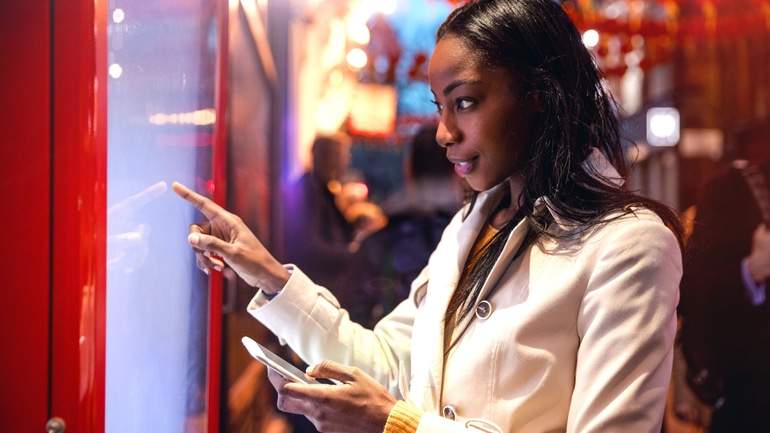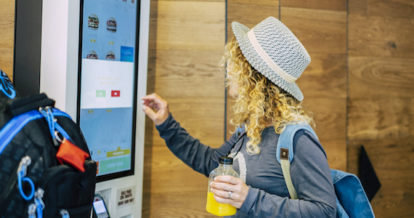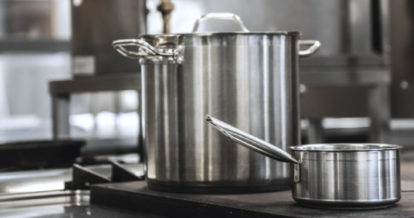In the past few years, self-ordering kiosks have become a staple at fast food and fast casual chains around the world. But while the McDonald’s and Paneras of the world went all-in on kiosks early on, independent restaurants have been much more hesitant and slow to adopt this kind of self-serve technology.
Now, the pandemic has radically changed the way independent restaurants think about self-ordering kiosks. What was once seen as costly and impersonal technology, is now considered a cost-effective solution for restaurants and a convenient option for customers.
And convenience is not the only benefit. Self-ordering kiosks have also helped restaurants reduce wait times, improve order accuracy, and, most importantly, boost check sizes – benefits that just about any restaurant can enjoy.
In this article, we dive into some of the reasons for the recent restaurant kiosk boom by covering:
- What is a self-ordering kiosk
- Why self-ordering kiosks are on the rise
- 5 important benefits of kiosks for restaurant
- What to look for when purchasing self-ordering kiosks for your own restaurant
Ready to find out why self-ordering kiosks could be your restaurant’s secret weapon?
What is a Self-Ordering Kiosk?
As you might have guessed from the name, a self-ordering kiosk gives guests the power to order and pay by themselves – kind of like a sophisticated vending machine, but for meals.
These systems usually consist of a touchscreen (often a tablet) equipped with an easy-to-use digital interface. This screen will display the restaurant’s menu and guide customers through the ordering process – from building their meal, to payment, and pickup. As the customer builds their order, the kiosk can also display prompts with different promotions or menu modifiers that guests might have not known about otherwise.
Why Self-Ordering Kiosks Are on the Rise
As mentioned, self-ordering kiosks aren’t exactly new. Prior to the pandemic, many major restaurant chains had already added self-ordering kiosks to their restaurants and quickly found success with the technology. McDonald’s reported that restaurants that introduced kiosks experienced an average 5% to 6% lift in sales. And when Chili’s added self-ordering kiosks to its tables, the chain saw a whopping 20% increase in dessert sales.
The reason for the bump in sales is largely due to changes in customer behavior. Customers have gotten used to the ease and speed of online ordering, and increasingly expect the same level of control, choice, and personalization when they visit a restaurant in person. Restaurant kiosks are specifically designed to provide this faster and more personalized ordering experience, making them perfectly positioned to meet customers’ changing expectations.
And it’s not just tech-savvy Millennials seeking greater control over their dining experience. A study by Tillster found that customers of all ages were eager to use self-ordering kiosks. In fact, 65% of those customers said they would visit a restaurant more often if self-service kiosks were offered, and 30% of customers saying they prefer to order from a self-ordering kiosk versus a cashier if the lines are of equal length.

While restaurants and customers were already warming to the idea of self-ordering kiosks, the pandemic caused the QSR technology to become even more popular, mainly due to its many safety benefits. Self-ordering kiosks helped restaurants promote social distancing because they allow customers to build their meal, place their order, and even pay – all without interacting with restaurant staff. Not to mention, AI restaurant technology has also advanced in recent years, making today’s kiosks smarter and more efficient than ever before.
5 Benefits of Self Ordering Kiosks for Restaurants
It’s clear that self-ordering kiosks are growing in popularity and not without good reason. Below, we dive into the five biggest benefits of self-ordering kiosks for restaurants like yours.
1. Increased Check Sizes
Perhaps the biggest benefit of self-ordering kiosks is the impact on average check sizes.
Instead of relying on your staff to highlight your high margin items and pricey add ons, your self-ordering kiosk can do it for you. With a self-ordering kiosk, there’s an option to push targeted and intuitive upsell prompts as guests are building their orders. This can include special promotions such as 2-for-1 deals, but it can also include strategic upsell tactics such as adding extra paid toppings, upgrading to premium sides, or making a meal a combo.
You’ll be pleasantly surprised when you check in on your POS reports to see the effect these little adds-ons have. Just take it from Taco Bell, which made 20% more money on digital orders, compared to those taken by human cashiers.
In the case of McDonald’s, the chain found that customers spent about one dollar more per order when using a kiosk, resulting in a 30% increase in average check size. McDonald’s also found that 20% of customers who didn’t initially order a drink would buy one when it was offered through the kiosk. And all that adds up to a lot more money in your pocket.
2. Decreased Wait Times
Another obvious benefit of self-ordering kiosks is that they speed up the ordering process.
Let’s face it, hungry customers hate waiting in lengthy lines. In fact, a study by Tillster found that if the line to order from a cashier is longer than 5 people, 75% of customers would choose to order from a self-service kiosk. And if the line is 10 people long? A whopping 91% say they would rather order from a restaurant kiosk.
A self-ordering kiosk can help to decrease those wait times by letting customers build their order, send it to the kitchen, and pay, all in just a few taps. Customers can then move out of the line to wait until their order is ready before picking it up from a designated counter.
While this may not seem like a significantly faster process, data from Appetize data showed that implementing kiosks reduced total order time by nearly 40%. Some restaurants, like one Moe’s Southwest Grill location in Pittsburgh, have even launched kiosk-only stores due to the operational efficiencies that come with faster ordering and shorter lines. And of course, all that time saved from standing in line means less time that customers and staff risk potential transmission of the coronavirus.
3. Enhance Order Accuracy
With your customers selecting and submitting their own orders, the margin of error for orders will decrease significantly. A kiosk with a visual menu is incredibly valuable in reducing miscommunication because it ensures that your patrons know exactly what they’re ordering, thereby preventing those “This isn’t what I ordered” conversations.
With increased order accuracy, your kitchen won’t be wasting time preparing an unordered item or incorrect dish. In turn, you won’t have to contend with angry customer complaints or negative online reviews. With self-ordering technology, you can ultimately make eating the cost of voids and discounts a thing of the past.
Increased order accuracy is especially important for restaurants these days because there are now fewer points of interaction with the customer. Since restaurants can no longer wow customers with the same level of hands-on dine-in service they used to, getting the food right has become the most important factor in providing a great customer experience.
4. Save Money on Labor
Self-ordering kiosks also help address the issue of productivity by giving restaurateurs the flexibility to move staff around. Front-of-house staff who used to take orders manually can now be reassigned to other tasks that increase sales and improve the customer experience.
Not only does this kind of flexible staffing improve productivity, but it can also help to reduce your labor costs overall. Though self-ordering kiosks can’t (and shouldn’t) replace all restaurant workers, it might mean that you need fewer workers during busy shifts. And for restaurants operating on a tight budget, saving money on one or two workers could help to keep operating costs low enough to stay afloat.

5. Keep Staff and Customers Confortable
In the wake of the pandemic, perhaps the biggest benefit of self-ordering kiosks is that they can help to keep customers and staff feeling comfortable by reducing in-person interactions. Even as the risk of infection subsides, some people may still feel more comfortable ordering from a kiosk than face-to-face.
Self-serve technology offers anxious guests a comfortable way to grab a meal by giving them the power to order and pay for their food all by themselves. Whether the kiosk is placed at the front of your restaurant or directly on each table, a kiosk allows a customer to place their order and send those orders directly to the kitchen without an in-person interaction with staff.
What to Look for When Purchasing a POS Kiosk
While it’s clear that kiosks offer many benefits for restaurants (and their customers), shopping for one isn’t as straightforward as it may seem.
The freestanding and wall-mounted kiosks you find at chain restaurants are often enterprise-level solutions that can cost thousands of dollars and require some labor-intensive installation. For most restaurants, these kinds of high-tech kiosks are not the ideal solution.
Instead, tablet-based kiosks that integrate with your existing POS system are a much more cost-effective and user-friendly option for independent restaurants if it’s available.

If you’re in the market for this kind of tablet-based restaurant kiosk, there are a few key features to look out for:
- Menu Building: Your restaurant kiosk should allow you to build a visually-appealing menu with photos of each item and allow customers to click on different menu options to view a description or list of ingredients.
- Menu Prompts: Look for kiosk software that allows you to easily add upsell prompts and menu modifiers to help boost average check size.
- Loyalty: Look for integrated loyalty solutions that can save customer’s information and store it for future orders or marketing initiatives.
- Customer Notifications: Improve efficiency by using a system that can alert customers when their orders are ready – either via individual screens or by sending a text or email directly to their mobile device.
- Variety Of Payment Options: Today’s customers increasingly want contactless payment options, so look for a kiosk that can accommodate magstripe, EMV chip cards, and mobile payments like Apple Pay. Just keep in mind that while some kiosks may be able to support cash payments, you may still need at least one cashier on hand to accommodate those who prefer to pay with cash.
There’s no question that self-ordering kiosks do require a bit of an upfront investment. However, experts predict that the demand for self-ordering kiosks isn’t going away any time soon. Even after the pandemic has largely subsided, self-ordering kiosks are expected to only grow in popularity thanks to the many benefits they offer customers and restaurateurs.
Free Restaurant Cleaning Checklist
Sign up for our free weekly TouchBistro Newsletter







